The archbishop's letter was published on The Remnant website with an introduction by Michael Matt. Check it out. Everything that has happened in the world and the church in the recent past shows exactly what a crisis exists in the Church. The novelties, the sacrilege, the casual disrespect, the loss of faith in the Real Presence, the ease with which our shepherds abandoned us and denied us the sacraments during the CCP virus -- they all point to a ship adrift, a situation that can't possibly be pleasing to Almighty God, our Captain! Read Viganò's letter, recognize the problems foisted on us through syncretism and modernism which were endemic to the Council, pray the Holy Spirit Prayer, and then listen to a modern prophet. If you only have a few minutes, read the red. It gives the tenor of the state of the emergency. God bless Archbishop Viganò, our modern Jeremiah!
Letter of Archbishop Carlo Maria Viganò
 9 June 2020
9 June 2020Saint Ephrem
The merit of His Excellency’s essay lies first of all in its grasp of the causal link between the principles enunciated or implied by Vatican II and their logical consequent effect in the doctrinal, moral, liturgical, and disciplinary deviations that have arisen and progressively developed to the present day. The monstrum generated in modernist circles could have at first been misleading, but it has grown and strengthened, so that today it shows itself for what it really is in its subversive and rebellious nature. The creature that was conceived at that time is always the same, and it would be naive to think that its perverse nature could change. Attempts to correct the conciliar excesses – invoking the hermeneutic of continuity – have proven unsuccessful: Naturam expellas furca, tamen usque recurret [Drive nature out with a pitchfork; she will come right back] (Horace, Epist. I,10,24). The Abu Dhabi Declaration – and, as Bishop Schneider rightly observes, its first symptoms in the pantheon of Assisi – “was conceived in the spirit of the Second Vatican Council” as Bergoglio proudly confirms.
This “spirit of the Council” is the license of legitimacy that the innovators use to oppose their critics, without realizing that it is precisely confessing that legacy that confirms not only the erroneousness of the present declarations but also the heretical matrix that supposedly justifies them. On closer inspection, never in the history of the Church has a Council presented itself as such a historic event that it was different from any other council: there was never talk of a “spirit of the Council of Nicea” or the “spirit of the Council of Ferrara-Florence,” even less the “spirit of the Council of Trent,” just as we never had a “post-conciliar” era after Lateran IV or Vatican I.
The reason is obvious: those Councils were all, indiscriminately, the expression in unison of the voice of Holy Mother Church, and for this very reason the voice of Our Lord Jesus Christ. Significantly, those who maintain the novelty of Vatican II also adhere to the heretical doctrine that places the God of the Old Testament in opposition to the God of the New Testament, as if there could be contradiction between the Divine Persons of the Most Holy Trinity. Evidently this opposition that is almost gnostic or cabbalistic is functional to the legitimization of a new subject that is voluntarily different and opposed to the Catholic Church. Doctrinal errors almost always betray some sort of Trinitarian heresy, and thus it is by returning to the proclamation of Trinitarian dogma that the doctrines that oppose it can be defeated: ut in confessione veræ sempiternæque deitatis, et in Personis proprietas, et in essentia unitas, et in majestate adoretur æqualitas: Professing the true and eternal Divinity, we adore what is proper to each Person, their unity in substance, and their equality in majesty.
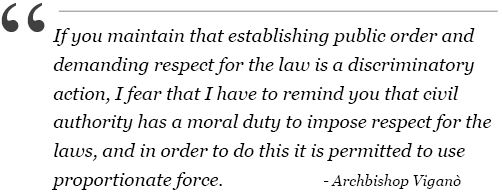
Bishop Schneider cites several canons of the Ecumenical Councils that propose, in his opinion, doctrines that today are difficult to accept, such as for example the obligation to distinguish Jews by their clothing, or the ban on Christians serving Muslim or Jewish masters. Among these examples there is also the requirement of the traditio instrumentorum declared by the Council of Florence, which was later corrected by Pius XII’s Apostolic Constitution Sacramentum Ordinis.
Bishop Athanasius comments: “One may rightly hope and believe that a future Pope or Ecumenical Council will correct the erroneous statement made” by Vatican II. This appears to me to be an argument that, although made with the best of intentions, undermines the Catholic edifice from its foundation. If in fact we admit that there may be Magisterial acts that, due to a changed sensitivity, are susceptible to abrogation, modification, or different interpretation with the passage of time, we inevitably fall under the condemnation of the Decree Lamentabili, and we end up offering justification to those who, recently, precisely on the basis of that erroneous assumption, declared that the death penalty “does not conform to the Gospel,” and thus amended the Catechism of the Catholic Church. And, by the same principle, in a certain way we could maintain that the words of Blessed Pius IX in Quanta Cura were in some manner corrected by Vatican II, just as His Excellency hopes could happen for Dignitatis Humanae.
Among the examples he presents, none of them is in itself gravely erroneous or heretical: the fact that the Council of Florence declared that the traditio instrumentorum was necessary for the validity of Orders did not in any way compromise priestly ministry in the Church, leading her to confer Orders invalidly. Nor does it seem to me that one can affirm that this aspect, however important, led to doctrinal errors on the part of the faithful, something which instead has occurred only with the most recent Council. And when in the course of history various heresies spread, the Church always intervened promptly to condemn them, as happened at the time of the Synod of Pistoia in 1786, which was in some way anticipatory of Vatican II, especially where it abolished Communion outside of Mass, introduced the vernacular tongue, and abolished the prayers of the Canon said submissa voce; but even more so when it theorized about the basis of episcopal collegiality, reducing the primacy of the pope to a mere ministerial function. Re-reading the acts of that Synod leaves us amazed at the literal formulation of the same errors that we find later, in increased form, in the Council presided over by John XXIII and Paul VI. On the other hand, just as the Truth comes from God, so error is fed by and feeds on the Adversary, who hates the Church of Christ and her heart: the Holy Mass and the Most Holy Eucharist.
There comes a moment in our life when, through the disposition of Providence, we are faced with a decisive choice for the future of the Church and for our eternal salvation. I speak of the choice between understanding the error into which practically all of us have fallen, almost always without evil intentions, and wanting to continue to look the other way or justify ourselves.
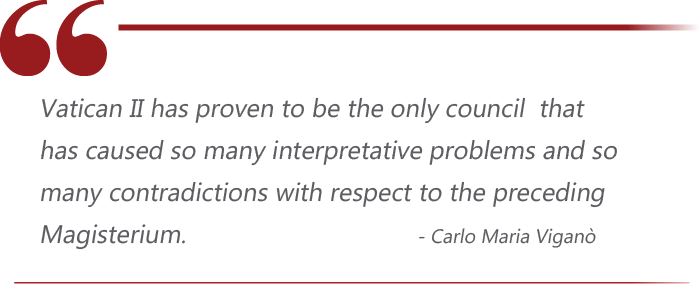
We have also committed the error, among others, of considering our interlocutors as people who, despite the difference of their ideas and their faith, were still motivated by good intentions and who would be willing to correct their errors if they could open up to our Faith. Together with numerous Council Fathers, we thought of ecumenism as a process, an invitation that calls dissidents to the one Church of Christ, idolaters and pagans to the one True God, and the Jewish people to the promised Messiah. But from the moment it was theorized in the conciliar commissions, ecumenism was configured in a way that was in direct opposition to the doctrine previously expressed by the Magisterium.
We have thought that certain excesses were only an exaggeration of those who allowed themselves to be swept up in enthusiasm for novelty; we sincerely believed that seeing John Paul II surrounded by charmers-healers , buddhist monks, imams, rabbis, protestant pastors and other heretics gave proof of the Church’s ability to summon people together in order to ask God for peace, while the authoritative example of this action initiated a deviant succession of pantheons that were more or less official, even to the point of seeing Bishops carrying the unclean idol of the pachamama on their shoulders, sacrilegiously concealed under the pretext of being a representation of sacred motherhood.
But if the image of an infernal divinity was able to enter into Saint Peter’s, this is part of a cresecendo which the other side foresaw from the beginning. Numerous practicing Catholics, and perhaps also a majority of Catholic clergy, are today convinced that the Catholic Faith is no longer necessary for eternal salvation; they believe that the One and Triune God revealed to our fathers is the same as the god of Mohammed. Already twenty years ago we heard this repeated from pulpits and episcopal cathedrae, but recently we hear it being affirmed with emphasis even from the highest Throne.
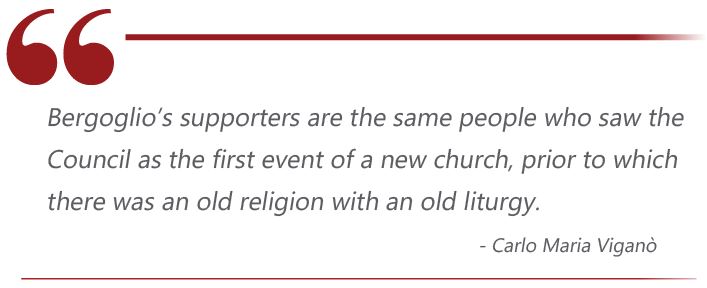
We know well that, invoking the saying in Scripture Littera enim occidit, spiritus autem vivificat [The letter brings death, but the spirit gives life (2 Cor 3:6)], the progressives and modernists astutely knew how to hide equivocal expressions in the conciliar texts, which at the time appeared harmless to most but that today are revealed in their subversive value. It is the method employed in the use of the phrase subsistit in: saying a half-truth not so much as not to offend the interlocutor (assuming that is licit to silence the truth of God out of respect for His creature), but with the intention of being able to use the half-error that would be instantly dispelled if the entire truth were proclaimed. Thus “Ecclesia Christi subsistit in Ecclesia Catholica” does not specify the identity of the two, but the subsistence of one in the other and, for consistency, also in other churches: here is the opening to interconfessional celebrations, ecumenical prayers, and the inevitable end of any need for the Church in the order of salvation, in her unicity, and in her missionary nature.
Some may remember that the first ecumenical gatherings were held with the schismatics of the East, and very prudently with other Protestant sects. Apart from Germany, Holland, and Switzerland, in the beginning the countries of Catholic tradition did not welcome mixed celebrations with Protestant pastors and Catholic priests together. I recall that at the time there was talk of removing the penultimate doxology from the Veni Creator so as not to offend the Orthodox, who do not accept the Filioque. Today we hear the surahs of the Koran recited from the pulpits of our churches, we see an idol of wood adored by religious sisters and brothers, we hear Bishops disavow what up until yesterday seemed to us to be the most plausible excuses of so many extremisms. What the world wants, at the instigation of Masonry and its infernal tentacles, is to create a universal religion that is humanitarian and ecumenical, from which the jealous God whom we adore is banished. And if this is what the world wants, any step in the same direction by the Church is an unfortunate choice which will turn against those who believe that they can jeer at God. The hopes of the Tower of Babel cannot be brought back to life by a globalist plan that has as its goal the cancellation of the Catholic Church, in order to replace it with a confederation of idolaters and heretics united by environmentalism and universal brotherhood. There can be no brotherhood except in Christ, and only in Christ: qui non est mecum, contra me est.
It is disconcerting that few people are aware of this race towards the abyss, and that few realize the responsibility of the highest levels of the Church in supporting these anti-Christian ideologies, as if the Church’s leaders want to guarantee that they have a place and a role on the bandwagon of aligned thought. And it is surprising that people persist in not wanting to investigate the root causes of the present crisis, limiting themselves to deploring the present excesses as if they were not the logical and inevitable consequence of a plan orchestrated decades ago. If the pachamama could be adored in a church, we owe it to Dignitatis Humanae. If we have a liturgy that is Protestantized and at times even paganized, we owe it to the revolutionary action of Msgr. Annibale Bugnini and to the post-conciliar reforms. If the Abu Dhabi Declaration was signed, we owe it to Nostra Aetate. If we have come to the point of delegating decisions to the Bishops’ Conferences – even in grave violation of the Concordat, as happened in Italy – we owe it to collegiality, and to its updated version, synodality.
Thanks to synodality, we found ourselves with Amoris Laetitia having to look for a way to prevent what was obvious to everyone from appearing: that this document, prepared by an impressive organizational machine, intended to legitimize Communion for the divorced and cohabiting, just as Querida Amazonia will be used to legitimize women priests (as in the recent case of an “episcopal vicaress” in Freiburg) and the abolition of Sacred Celibacy. The Prelates who sent the Dubia to Francis, in my opinion, demonstrated the same pious ingenuousness: thinking that Bergoglio, when confronted with the reasonably argued contestation of the error, would understand, correct the heterodox points, and ask for forgiveness.
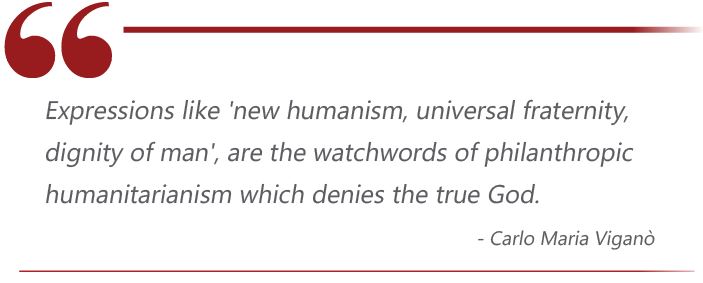
The Council was used to legitimize the most aberrant doctrinal deviations, the most daring liturgical innovations, and the most unscrupulous abuses, all while Authority remained silent. This Council was so exalted that it was presented as the only legitimate reference for Catholics, clergy, and bishops, obscuring and connoting with a sense of contempt the doctrine that the Church had always authoritatively taught, and prohibiting the perennial liturgy that for millennia had nourished the faith of an uninterrupted line of faithful, martyrs, and saints. Among other things, this Council has proven to be the only one that has caused so many interpretative problems and so many contradictions with respect to the preceding Magisterium, while there is not one other council – from the Council of Jerusalem to Vatican I – that does not harmonize perfectly with the entire Magisterium or that needs so much interpretation.
I confess it with serenity and without controversy: I was one of the many people who, despite many perplexities and fears which today have proven to be absolutely legitimate, trusted the authority of the Hierarchy with unconditional obedience. In reality, I think that many people, including myself, did not initially consider the possibility that there could be a conflict between obedience to an order of the Hierarchy and fidelity to the Church herself. What made tangible this unnatural, indeed I would even say perverse, separation between the Hierarchy and the Church, between obedience and fidelity, was certainly this most recent Pontificate.
In the Room of Tears adjacent to the Sistine Chapel, while Msgr. Guido Marini prepared the white rocchetto, mozzetta, and stole for the first appearance of the “newly elected” Pope, Bergoglio exclaimed: “Sono finite le carnevalate! [The carnivals are over!],” scornfully refusing the insignia that all the Popes up until then had humbly accepted as the distinguishing garb of the Vicar of Christ. But those words contained truth, even if it was spoken involuntarily: on March 13, 2013, the mask fell from the conspirators, who were finally free of the inconvenient presence of Benedict XVI and brazenly proud of having finally succeeded in promoting a Cardinal who embodied their ideals, their way of revolutionizing the Church, of making doctrine malleable, morals adaptable, liturgy adulterable, and discipline disposable. And all this was considered, by the protagonists of the conspiracy themselves, the logical consequence and obvious application of Vatican II, which according to them had been weakened by the critiques expressed by Benedict XVI. The greatest affront of that Pontificate was liberally permitting the celebration of the venerated Tridentine Liturgy, the legitimacy of which was finally recognized, disproving fifty years of its illegitimate ostracization. It is no accident that Bergoglio’s supporters are the same people who saw the Council as the first event of a new church, prior to which there was an old religion with an old liturgy.
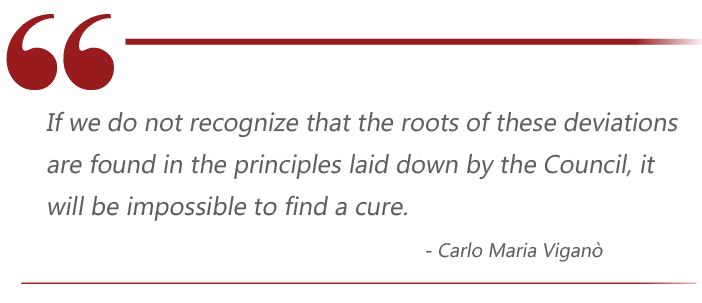
It is no accident: what these men affirm with impunity, scandalizing moderates, is what Catholics also believe, namely: that despite all the efforts of the hermeneutic of continuity which shipwrecked miserably at the first confrontation with the reality of the present crisis, it is undeniable that from Vatican II onwards a parallel church was built, superimposed over and diametrically opposed to the true Church of Christ. This parallel church progressively obscured the divine institution founded by Our Lord in order to replace it with a spurious entity, corresponding to the desired universal religion that was first theorized by Masonry. Expressions like new humanism, universal fraternity, dignity of man, are the watchwords of philanthropic humanitarianism which denies the true God, of horizontal solidarity of vague spiritualist inspiration and of ecumenical irenism that the Church unequivocally condemns. “Nam et loquela tua manifestum te facit [Even your speech gives you away]” (Mt 26, 73): this very frequent, even obsessive recourse to the same vocabulary of the enemy betrays adherence to the ideology he inspires; while on the other hand the systematic renunciation of the clear, unequivocal and crystalline language of the Church confirms the desire to detach itself not only from the Catholic form but even from its substance.
What we have for years heard enunciated, vaguely and without clear connotations, from the highest Throne, we then find elaborated in a true and proper manifesto in the supporters of the present Pontificate: the democratization of the Church, no longer through the collegiality invented by Vatican II but by the synodal path inaugurated by the Synod on the Family; the demolition of the ministerial priesthood through its weakening with exceptions to ecclesiastical celibacy and the introduction of feminine figures with quasi-sacerdotal duties; the silent passage from ecumenism directed towards separated brethren to a form of pan-ecumenism that reduces the Truth of the One Triune God to the level of idolatries and the most infernal superstitions; the acceptance of an interreligious dialogue that presupposes religious relativism and excludes missionary proclamation; the demythologization of the Papacy, pursued by Bergoglio as a theme of his pontificate; the progressive legitimization of all that is politically correct: gender theory, sodomy, homosexual marriage, Malthusian doctrines, ecologism, immigrationism... If we do not recognize that the roots of these deviations are found in the principles laid down by the Council, it will be impossible to find a cure: if our diagnosis persists, against all the evidence, in excluding the initial pathology, we cannot prescribe a suitable therapy.
This operation of intellectual honesty requires a great humility, first of all in recognizing that for decades we have been led into error, in good faith, by people who, established in authority, have not known how to watch over and guard the flock of Christ: some for the sake of living quietly, some because of having too many commitments, some out of convenience, and finally some in bad faith or even malicious intent. These last ones who have betrayed the Church must be identified, taken aside, invited to amend and, if they do not repent they must be expelled from the sacred enclosure. This is how a true Shepherd acts, who has the well-being of the sheep at heart and who gives his life for them; we have had and still have far too many mercenaries, for whom the consent of the enemies of Christ is more important than fidelity to his Spouse.
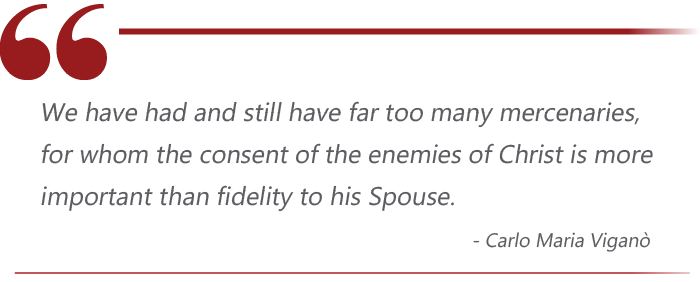
Just as I honestly and serenely obeyed questionable orders sixty years ago, believing that they represented the loving voice of the Church, so today with equal serenity and honesty I recognize that I have been deceived. Being coherent today by persevering in error would represent a wretched choice and would make me an accomplice in this fraud. Claiming a clarity of judgment from the beginning would not be honest: we all knew that the Council would be more or less a revolution, but we could not have imagined that it would prove to be so devastating, even for the work of those who should have prevented it. And if up until Benedict XVI we could still imagine that the coup d’état of Vatican II (which Cardinal Suenens called “the 1789 of the Church”) had experienced a slowdown, in these last few years even the most ingenuous among us have understood that silence for fear of causing a schism, the effort to repair papal documents in a Catholic sense in order to remedy their intended ambiguity, the appeals and dubia made to Francis that remained eloquently unanswered, are all a confirmation of the situation of the most serious apostasy to which the highest levels of the Hierarchy are exposed, while the Christian people and the clergy feel hopelessly abandoned and that they are regarded by the bishops almost with annoyance.
The Abu Dhabi Declaration is the ideological manifesto of an idea of peace and cooperation between religions that could have some possibility of being tolerated if it came from pagans who are deprived of the light of Faith and the fire of Charity. But whoever has the grace of being a Child of God in virtue of Holy Baptism should be horrified at the idea of being able to construct a blasphemous modern version of the Tower of Babel, seeking to bring together the one true Church of Christ, heir to the promises made to the Chosen People, with those who deny the Messiah and with those who consider the very idea of a Triune God to be blasphemous. The love of God knows no measure and does not tolerate compromises, otherwise it simply is not Charity, without which it is not possible to remain in Him: qui manet in caritate, in Deo manet, et Deus in eo [whoever remains in love remains in God and God in him] (1 Jn 4:16).
It matters little whether it is a declaration or a Magisterial document: we know well that the subversive mens [mind] of the innovators plays games with these sort of quibbles in order to spread error. And we know well that the purpose of these ecumenical and interreligious initiatives is not to convert those who are far from the one Church to Christ, but to divert and corrupt those who still hold the Catholic Faith, leading them to believe that it is desirable to have a great universal religion that brings together the three great Abrahamic religions “in a single house”: this is the triumph of the Masonic plan in preparation for the kingdom of the Antichrist!
Whether this materializes through a dogmatic Bull, a declaration, or an interview with Scalfari in La Repubblica matters little, because Bergoglio’s supporters wait for his words as a signal to which they respond with a series of initiatives that have already been prepared and organized for some time. And if Bergoglio does not follow the directions he has received, ranks of theologians and clergy are ready to lament over the “solitude of Pope Francis” as a premise for his resignation (I think for example of Massimo Faggioli in one of his recent essays). On the other hand, it would not be the first time that they use the Pope when he goes along with their plans and get rid of him or attack him as soon as he does not.
Last Sunday, the Church celebrated the Most Holy Trinity, and in the Breviary it offers us the recitation of the Symbolum Athanasianum, now outlawed by the conciliar liturgy and already reduced to only two occasions in the liturgical reform of 1962. The first words of that now-disappeared Symbolum remain inscribed in letters of gold: “Quicumque vult salvus esse, ante omnia opus est ut teneat Catholicam fidem; quam nisi quisque integram inviolatamque servaverit, absque dubio in aeternum peribit – Whosoever wishes to be saved, before all things it is necessary that he hold the Catholic faith; For unless a person shall have kept this faith whole and inviolate, without doubt he shall eternally perish.”
+ Carlo Maria Viganò
Translated by Giuseppe Pellegrino

“They will eliminate faith from the earth by little and little” Words from heaven without doubt. “Rome will lose the faith and become the seat of the Antichrist” Our Lady Spouse of God the Holy Spirit who knows all things, even our most secret thoughts is always ahead of the devil’s posse. This is 1846, shortly before the communists published their manifesto. How wilfully ignorant can modern educated Vatican Type Two Catholics be? Why was there such opposition to the message of Our Lady of La Salette on behalf of priests and bishops? “His letter will be “B”. Oh dear! I’m not sure of the exact words but didn’t she say that convents or monasteries were dens of “Asmodeus and his like”! Did she say that true priests were scarce and would lead lukewarm souls to hell along with themselves.
ReplyDeleteHere in Ireland we don’t (yet) use the expression “lose it” but the day that Rome did intentionally “lose it”, the faith, is the Feast of the Immaculate Conception 1965. The penny catechisms were abandoned and the new easy faith and easy church was warmly embraced especially by women. Another bite of the apple! Up next “easy mass”. 1969, the year Catholics went to the moon.
COVID1965 Council of Vatican Infiltrating Democrats. A world being made safe for democracy.
Our Lady at La Salette, as at Lourdes, left a new stream of water, again indicating the worldwide war against “her seed” immaculate water baptism without which everlasting hell is certain.
Thank you for publishing that comment. It was only afterwards that I remembered the last words (or nearly last words) of Our Lady’s La Salette message. “You must fight children of light, you the few who can see, for now is the time of all times, the end of all ends”. She is looking for what she described as “The Apostles of the last days”. The first Apostles were the Apostles of Jesus Christ. The last will be the Apostles of the Queen of Apostles Mary, God’s only human creature conceived without sin. “I will put enmities (myriad enmities) between you and the woman and thy seed and her seed” Genesis 3:15 The devil’s war against her seed, the one only water Baptism intended to regenerate a soul to the immaculate state which is necessary for entry to heaven, begins now against souls in the womb. It is so necessary that even an atheist can do it provided the intention is to do what the Church does. It is not “welcoming into the community”. We are either PROLIFE, Pro Christ the way, Truth and the life or Anti-life and Antichrist. We who are the “frontline” workers (laity) of his Eternal Royal Priesthood are tasked with teaching and baptising all nations. If the world peacemongering popes and bishops will not do it then we must do it if we hope to save our own souls. For Him or against Him. Gatherers or scatterers. “I give you peace, not as the world gives it”.
ReplyDelete"...so today with equal serenity and honesty I recognize that I have been deceived."
ReplyDeleteGod give us what we need. Thanks be to God for Abp Vigano and this letter.
The SSPX and sedevacantists have been saying this for decades. Glad you are finally waking up.
ReplyDelete
ReplyDeleteBishop Athanasius Schneider and the Lefebvrists are unable to tell the Congregation for the Doctrine of the Faith(CDF) that they are using a false premise to interpret Vatican Council II and other magisterial documents. Since Schneider himself inteprets Vatican Council II with the false premise and inference and then does not like the expected conclusion.He then blames the Council and calls for a Syllabus of Errors.
Bishop Schneider like the CDF, wants Brother Andre Marie, MICM, Prior at the St. Benedict Center, N.H, USA to interpret 1) Vatican Council II(LG 8, UR 3, GS 22 etc) 2) the dogma extra ecclesiam nulla salus (EENS) 3) the baptism of desire(BOD), baptism of blood(BOB) and invincible ignorance(I.I) 4) Catechism of the Catholic Church n.846 Outside the Church No Salvation 5)Athanasius Creed( all need Catholic faith for salvation) 6) Catechism of Pope Pius X ( 24 Q, 27 Q) 7) Syllabus of Errors of Pope Pius IX ( ecumenism, other religions and salvation) etc with a false premise.
In this way there is a rejection of the traditional teaching on exclusive salvation in the Catholic Church.
The alleged traditionalist will also be interpreting Quanta Cura, Mystici Corporis etc with the false premise to create a rupture with the Athanasius Creed and EENS. Since wherever BOD,BOB and I.I are mentioned in these texts , he will project them as 1) visible examples of salvation outside the Catholic Church, non Catholics saved without faith and baptism and so they are 2) exceptions to EENS, Syllabus of Errors etc. on exclusive salvation.For me BOD, BOB and I.I refer to hypothetical and theoretical cases only. So Mystici Corporis etc do not contradict Feeneyite EENS.
Bishop Schneider does not make the distinction between invisible-visible,implicit-explicit,subjective-objective and what is unknown and known.
So he supports the CDF which only allows vocations to the religious life, if a candidate, rejects exclusive salvation in the Church by confusing what is invisible as visible, hypothetical as real.
Similarly he expects the Society of St. Pius X(SSPX) to accept Vatican Council II interpreted with the false premise, to receive canonical recognition, like the St. Benedict Center, Still River, USA( not to be confused with the community at Richmond ,New Hampshire).
The traditionalists at St. Benedict Center, Still River, where Brother Thomas Augustine MICM is the Prior in the diocese of Worcester, USA,have to condone Vatican Council II interpreted with the false premise by the bishop Robert McManus.So he has granted them canonical recognition approved by the CDF.
If Brother Andre Marie MICM,Prior at SBC, New Hampshire, would interpret Vatican Council II with the false premise and so negate Feeneyite EENS, he too would be approved by the CDF and the diocese of Manchester, where the bishop is Peter Libasci.
The CDF and Bishop Schneider are not asking religious communities to interpret Vatican Council II with the false premise.They do not want to offend the Jewish Left rabbis and those who persecute with Leftist laws.
The CDF, Bishop Schneider and Cardinal Braz de Avez want the Franciscans of the Immaculate to interpret Vatican Council II with the false premise to create a rupture with Tradition. They are not telling the Franciscans of the Immaculate to interpret Vatican Council II in continuity with exclusive salvation in the Catholic Church.
Without the false premise there is no theological opening for the new ecumenism and the Christian theology of religious pluralism.
Vigano and Schneider do not comment upon these points. When Vatican Council II is interpreted rationally Ad Gentes 7 says all need faith and baptism for salvation and there are no exceptions to AG 7 mentioned in the text of Vatican Council II.-Lionel Andrades
Tom A,
ReplyDeleteI don't think the SSPX and the sedevacantists belong in the same sentence.
Catholic Mission,
I don't know anything about the St. Benedict Center except that the CDF have prohibited the sacraments there. https://www.catholicnh.org/about/stay-informed/media-releases/st-benedict-center-status/